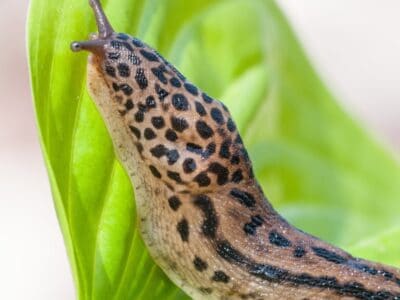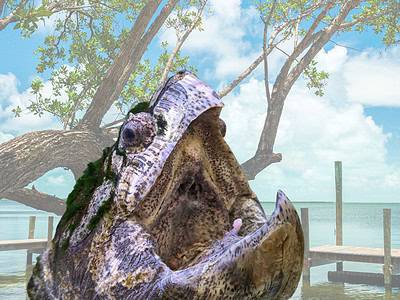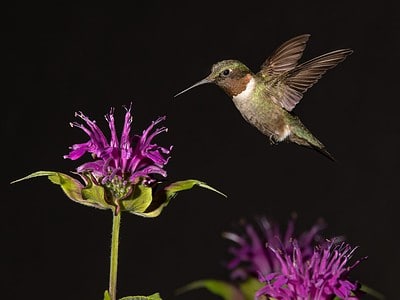White Ferret / Albino Ferrets
Mustela putorius furo
There are two different types of white ferrets!
Advertisement
White Ferret / Albino Ferrets Scientific Classification
- Kingdom
- Animalia
- Phylum
- Chordata
- Class
- Mammalia
- Order
- Carnivora
- Family
- Mustelidae
- Genus
- Mustela
- Scientific Name
- Mustela putorius furo
Read our Complete Guide to Classification of Animals.
White Ferret / Albino Ferrets Conservation Status
White Ferret / Albino Ferrets Locations
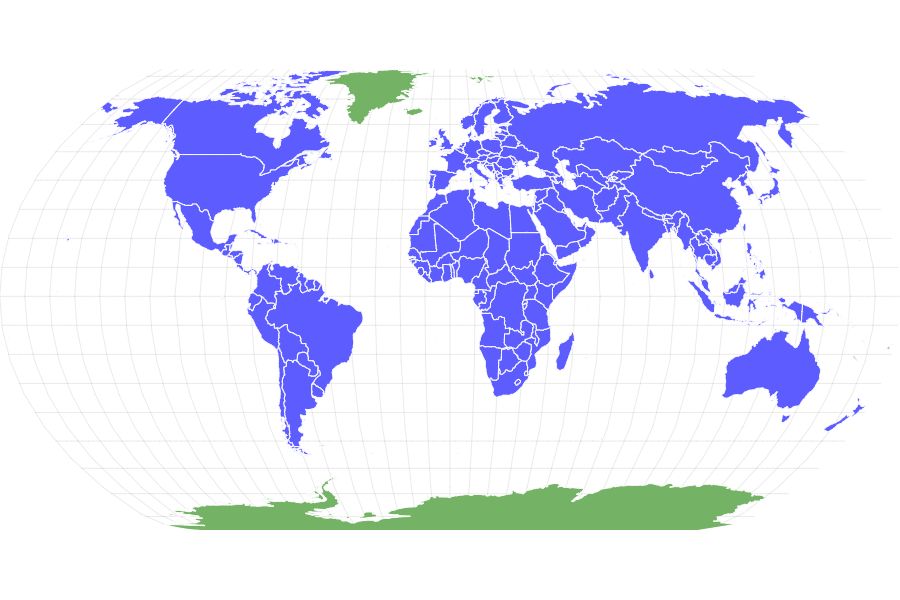
White Ferret / Albino Ferrets Facts
- Name Of Young
- kit
- Group Behavior
- Social
- Fun Fact
- There are two different types of white ferrets!
- Estimated Population Size
- 5-7 million (U.S. alone)
- Biggest Threat
- Inability to survive in the wild
- Most Distinctive Feature
- White coat
- Other Name(s)
- Albino ferret
- Gestation Period
- 39-42 days
- Litter Size
- 3-7
- Habitat
- Fully domesticated
- Predators
- Birds of prey, foxes, coyotes, wild cats (wild)
- Diet
- Carnivore
- Favorite Food
- Kibble, raw meat, dairy and produce
- Type
- Mammal
- Common Name
- White ferret
- Number Of Species
- 1
- Location
- global
- Group
- Highly sociable
White Ferret / Albino Ferrets Physical Characteristics
- Color
- White
- Skin Type
- Hair
- Top Speed
- 14 mph
- Lifespan
- 5-10 years
- Weight
- 1.5 - 4.5 lbs
- Height
- 15” avg + tail
- Length
- 6” avg
- Age of Sexual Maturity
- 4 - 8 months
- Age of Weaning
- 6 weeks
View all of the White Ferret / Albino Ferrets images!

The emergence of white fur, like the white Ferret, in nature is often a rousing success or a lethal failure and rarely little in between.
The snowshoe hare — which shows off-white fur to hide in the snow during the winter and a browner coat in the off-seasons — has learned that even in the right environment, white isn’t always a good look. But the common ferret is unique in that white incidence of the species has actually been bred into members of the species intentionally and for purely aesthetic purposes.
See all of our expert product reviews.
And since the common ferret is a distinct subspecies of the European polecat with no wild counterparts, predators don’t factor into the survival of white members of the species. In fact, white ferrets can actually take two forms: fully albino ferrets and those that simply possess all or mostly white fur.
White Ferret Facts

Ferrets with dark-eyed white fur have a greater probability of being deaf, whereas albino ferrets usually experience some hearing loss but are seldom entirely deaf.
©Couperfield/Shutterstock.com
- Dark-eyed whites are more likely to be deaf, while albino ferrets are often hard of hearing but rarely fully deaf.
- All ferret kits are born with fully white coats, although most of them begin to develop a set of darker colors and patterns at around three weeks old.
- The critically endangered black-footed ferret is the only other animal to wear the title of ferret, though they’re only distantly related by way of sharing the European polecat as an ancestor.
- Thanks to selective breeding, neither dark-eyed white ferrets nor albino ferrets are especially rare — and either can be found for around the same price as ferrets in other colors and patterns.
Scientific Name
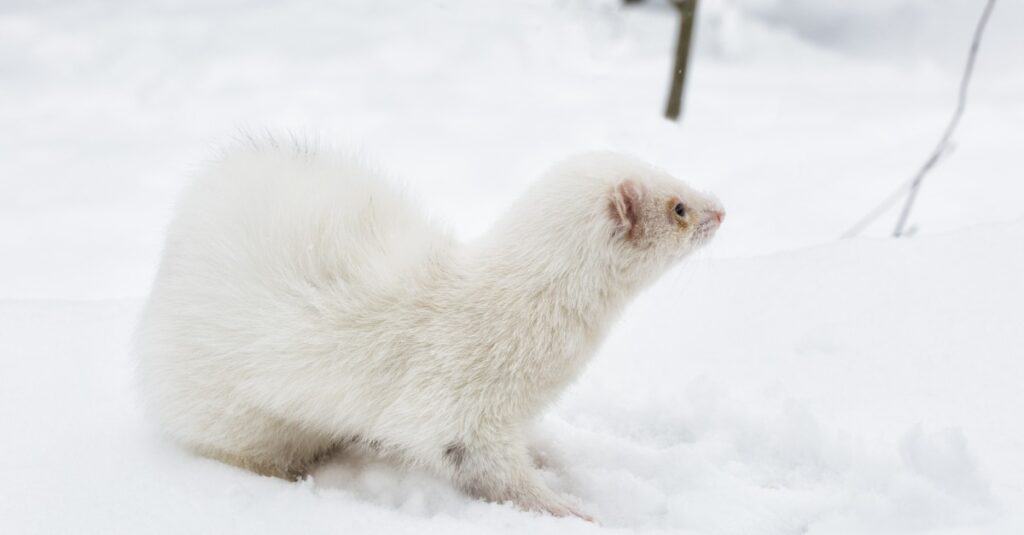
Ferrets are recognized taxonomically as Mustela putorius furo, which technically categorizes them as a subspecies of the European polecat (Mustela putorius), their direct ancestor.
©iStock.com/Lenorlux
Health and Entertainment for your White Ferret / Albino Ferrets
See all of our expert product reviews.
Since they’re just regular ferrets with either an instance of albinism or a dark-eyed white coloration, white ferrets don’t have a distinct species name — but the scientific name of the common ferret actually tells us a lot.
The taxonomic identification for this species is Mustela putorius furo, and that technically makes ferrets a subspecies of their direct ancestor the European polecat (Mustela putorius).
As members of the genus Mustela, both European polecats and common ferrets are part of the weasel family (Mustelidae) and are related to the mink and stoat.
The white ferret’s taxonomy tells us a lot, but we can also learn quite a bit by translating Latin.
- Mustela: The full word — which refers to the genus that both the European polecat and the ferret belong to — translates directly as a weasel, which is itself derived from “mus”, or “mouse”.
- Putorius: The English word putrefaction is a particularly vivid way of referring to the decomposition process. It’s also derived from this Latin word, which assigns the smell of rotting flesh as a point of identification for these creatures.
- Furo: It’s likely that this is a reference to the Latin word “fur”, which translates to “thief” or “robber” It’s a name that fits given how deft and curious these creatures are. But this word could also be plausibly translated from Latin as cat.
Evolution and Origins
Ferrets are part of the Mustelidae family, which also encompasses species like polecats, stoats, and ermines. Domestic ferrets are thought to have originated from the European polecat and were domesticated roughly 2,500 years ago.
Ferrets are taxonomically classified as Mustela putorius furo, which designates them as a subspecies of their ancestor, the European polecat (Mustela putorius).
Furthermore, every existing ferret originates from the Stromer’s polecat (Mustela stromeri), a diminutive European species from the Middle Pleistocene era (roughly 790,000 to 130,000 years ago).
Appearance
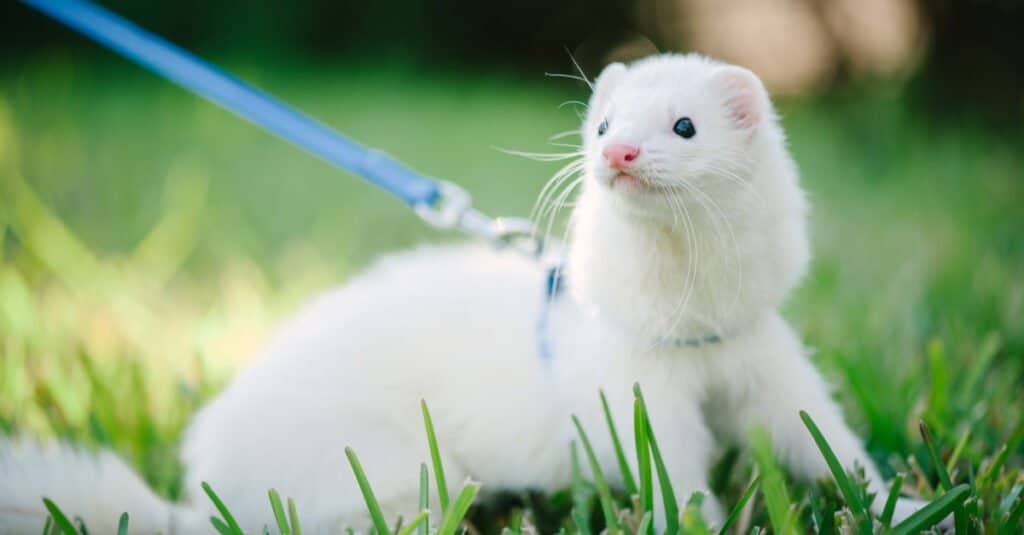
©Tom Lester/Shutterstock.com
Apart from their coats, these cute ferrets are indistinguishable from their darker and more colorful counterparts. The difference is merely one of pigmentation. There are some points of differentiation between the two distinct types of white ferret though. The easiest point of identification is the eyes.
Albinism causes ferrets to develop bright red eyes, while dark-eyed ferrets aptly enough have black eyes. Dark-eyed ferrets will sometimes have slight coloration or patterns in other colors or shades, and that can be another sure sign that you’re not dealing with an albino ferret.
While short-haired ferrets are the most common breeds, you can also find albino and dark-eyed white ferrets with long hair or even afghan fur.
Behavior
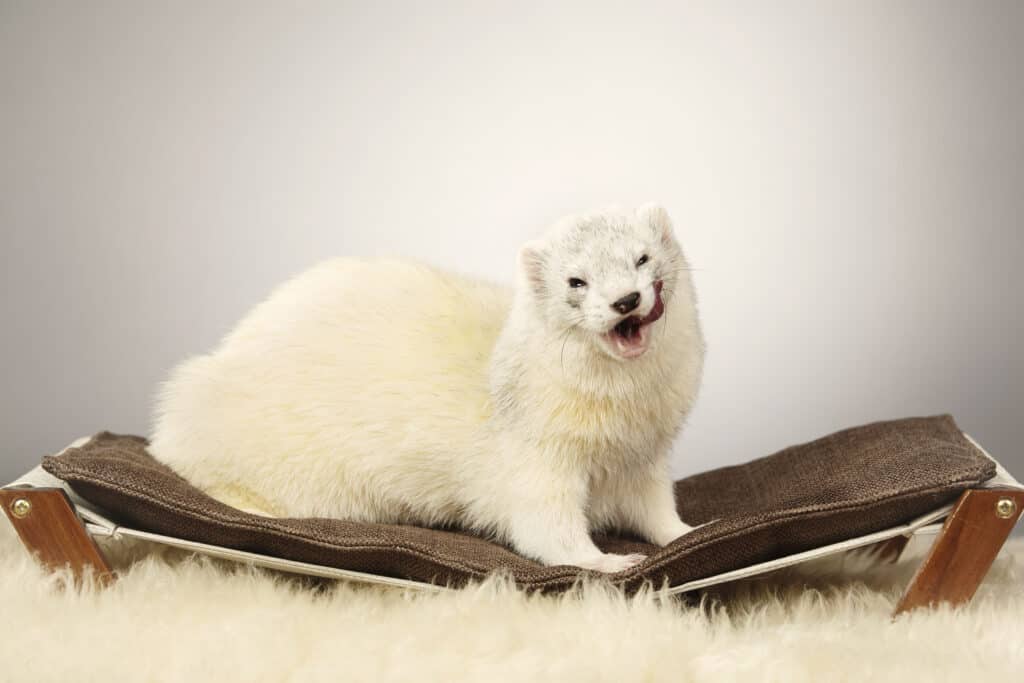
White ferrets exhibit the same behavior as other ferrets; they are lively and playful animals with flexible and nimble bodies tthat enables them to effortlessly maneuver and climb on virtually any surface.
©Couperfield/Shutterstock.com
White ferrets are the same as ferrets in terms of behavior — energetic and mischievous creatures with slinky and agile bodies that allow them to sneak practically anywhere and climb onto any surface. Being white at least means that you can potentially find where they’re hiding more easily.
It is important to keep in mind that ferrets are wild animals and obligate carnivores who can be easily scared. This is something to be doubly cautious about when dealing with a white ferret.
Albino ferrets are often hard of hearing because of smaller components in their inner ear, and the lack of pigmentation in the lens of their eyes leaves them with terrible vision.
Dark-eyed white ferrets are also one of the variations more prone to deafness acquired by a condition known as Waardenburg Syndrome. You may need to adjust your behavior to avoid scaring white ferrets as a result of these sensory limitations.
Habitat
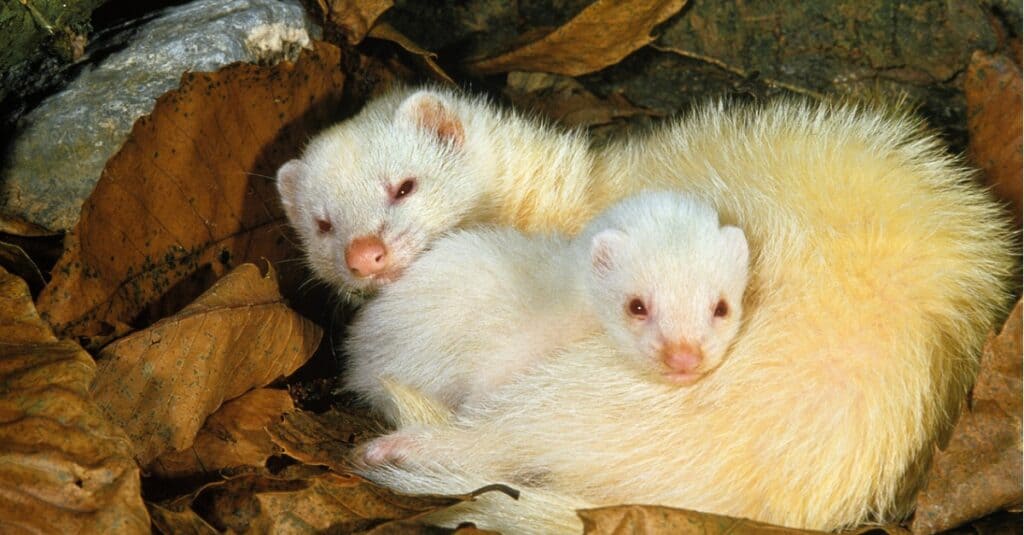
Assuming ferrets lived in their natural habitat, they would probably rely on their innate polecat instincts to either excavate underground tunnels for shelter or commandeer existing tunnels previously occupied by creatures such as rabbits, moles, or snakes.
©iStock.com/slowmotiongli
If ferrets were to live in the wild, they’d likely follow the instincts they inherited from the polecat and either dig burrows to hide in or abscond with burrows left behind by moles, rabbits, or snakes.
They still adore digging through anything, and many human companions of ferrets make sure to equip their habitats with plenty of different materials to burrow into.
Habitats should generally be 2′ x 2′ x 3′ and include a secure door. Ferrets are known for being escape artists, and white ferrets are no exception. When dealing with albinos, you should be especially aware of the lighting since they’re especially photosensitive.
Diet

The facts are that the ferret we know today never had to exist in anything resembling the wild, but they once served a purpose as more than just mischievous companions and itinerate thieves.
Five centuries before the beginning of the Common Era, ferrets were initially tamed to hunt rats, mice, and rabbits. That’s also where they got their high sense of energy.
Ferrets were voracious hunters with long and flexible bodies that allowed them to chase their prey into burrows and holes. They aren’t quite such capable hunters now, but that legacy makes a convincing argument for feeding raw meat like chicken and beef or even live meals to a ferret.
There are also a number of different dry food brands catered to the needs of ferrets as well as an extensive selection of treats.
Predators and Threats
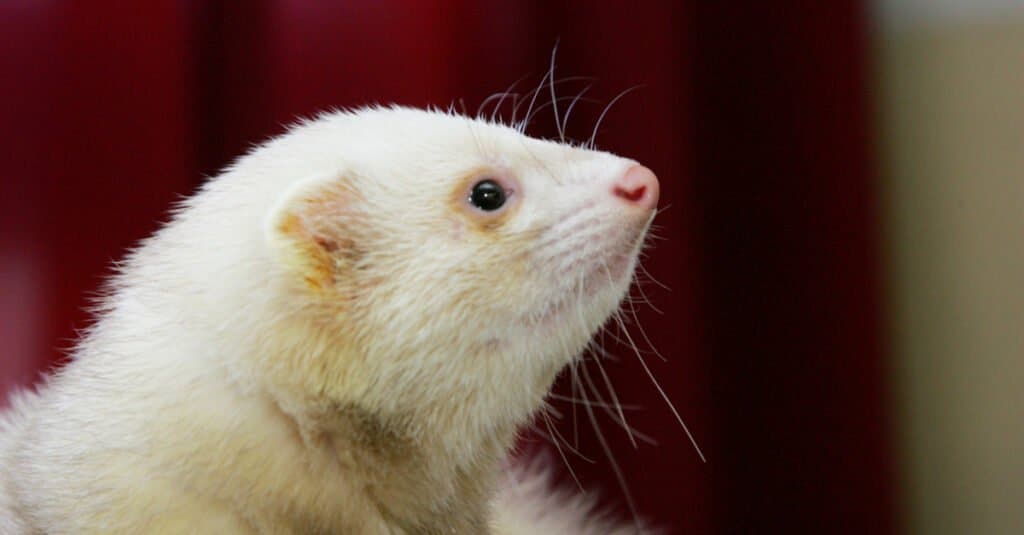
Young white ferret (Mustela putorius furo) close up.Although abandoned dogs may sometimes form packs and feral cat colonies can pose a threat to local bird populations, the domestication process has rendered ferrets completely dependent on humans, making it impossible for them to survive in the wild without human care.
©AJSTUDIO PHOTOGRAPHY/Shutterstock.com
While dogs left in the wild are sometimes known to revert to their native instincts and run in packs and colonies of domesticated cats can decimate a community’s bird population, the domestication of the ferret has left it utterly incapable of surviving in the wilderness. The ferret as it exists today never has to exist in the wild, and thousands of years of domestication have left it incapable of functioning in an ecosystem it’s thrown into.
While their fellow domesticated animals can breed and procreate after being released into the wild, the closest relative to the ferret to live in the wild is the European polecat. And unless they’re long-haired and left in the snow, their white fur is only going to make them an obvious target for predators.
In the average neighborhood where pet ferrets are kept, this could mean everything from birds of prey like hawks and eagles to wild scavengers like coyotes and foxes to house cats and pet dogs.
Reproduction and Life Cycle
While some convey the red eyes and white fur of albino ferrets with sickliness, these cute ferrets don’t actually have any distinct vulnerabilities to disease or negative health conditions. The average ferret is fully weaned after three to six weeks and will reach sexual maturity around the age of six months. The lifespan of a white ferret is the same as the lifespan of any other ferret — seven to ten years.
Ferret mating season falls anywhere from the spring to the summer, and a mother can give birth to as many as seven kits in a litter. Since ferrets are fully domesticated breeds with no actual predators, the population could quickly grow out of control if not for conscientious breeding habits from humans.
Population
While there’s no global estimate on the population size for either albino or dark-eyed white ferrets, the prices associated with these pets can tell us a decent amount about how rare they are in the overall ferret population. Both types of white albinos can sometimes be found for $50, making them among some of the more affordable choices.
In the wild, these sorts of traits would be rare — but we’ve been thousands of years meticulously breeding these traits through one generation after another. There are believed to be at least five million pet ferrets in the United States today, and neither the subspecies nor its white-coated members are going anywhere anytime soon. But the related black-footed ferret is another story.
With a population that hovers around 300, they’re the most endangered mammal in North America.
View all 108 animals that start with WWhite Ferret / Albino Ferrets FAQs (Frequently Asked Questions)
Are white ferrets carnivores, herbivores, or omnivores?
White ferrets are obligate carnivores, which means that they require nutrients that can only naturally be found in meat to survive. Despite this, many pet ferrets enjoy the occasional vegetable, fruit, or dairy treat.
What qualifies a ferret as albino?
While white ferrets do exist that aren’t albinos, albino ferrets possess a genetic disorder. Albinism reduces the amount of pigmentation a creature produces, resulting in white fur and red eyes. Many breeders have selectively bred albinism out of a demand for uniquely cute ferrets, and the trait isn’t particularly rare anymore.
How much is an albino ferret?
An albino ferret from a breeder can cost anywhere from 50 to 150 dollars. That makes these ferrets with a rare disorder one of the cheaper choices. You could pay as much as $500 for a rare cinnamon ferret.
Where can I buy an albino ferret?
If you want an albino ferret, your best bet is to go to a breeder. Just be sure to carefully vet their credentials to make sure that they’re humanely breeding and raising their animals.
Are all white ferrets albino?
Albino ferrets are identifiable by their bright red eyes, but dark-eyed whites are a popular alternative. Their fur is mostly or completely white, and it’s the result of a natural expression of pigmentation genes rather than a genetic disorder.
How rare is an albino ferret?
While the facts about albinism rates are a bit ambiguous and can vary by species, rates of albinism in the wild are estimated to be anywhere between 1 in 20,000 and 1 in a million. But thanks to conscious breeding efforts of domesticated ferrets, albino ferrets are generally quite common.
What do albino ferrets eat?
Albino ferrets eat the same food that any other domesticated ferrets do. As obligate carnivores, they need a diet that’s about 35% protein and 20% fat. The healthiest approach for a ferret’s diet is to feed it raw meat, although there are a number of dry food options for ferrets as well.
Are albino ferrets deaf?
Though their small inner ear leaves many albino ferrets hard of hearing, they’re not often deaf. You’re actually more likely to find a deaf ferret by investing in a dark-eyed white, as these ferrets are particularly prone to a condition known as Waardenburg syndrome associated with deafness.
Are albino ferrets blind?
All ferrets are prone to vision issues, but the lack of pigmentation in an albino ferret’s eyes can leave them especially vulnerable to bright or harsh lighting. While you should be especially sensitive about mood lighting in your home if you have an albino ferret, blindness doesn’t need to be a primary concern.
Thank you for reading! Have some feedback for us? Contact the AZ Animals editorial team.
Sources
- ITIS / Accessed February 10, 2022
- U.S. Food & Drug / Accessed February 10, 2022
- Pets on Mom / Accessed February 10, 2022
- Live Science / Accessed February 10, 2022
- Purdue University / Accessed February 10, 2022








